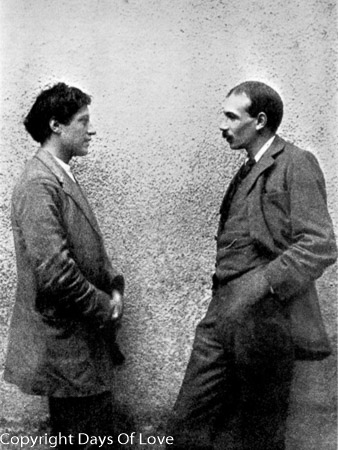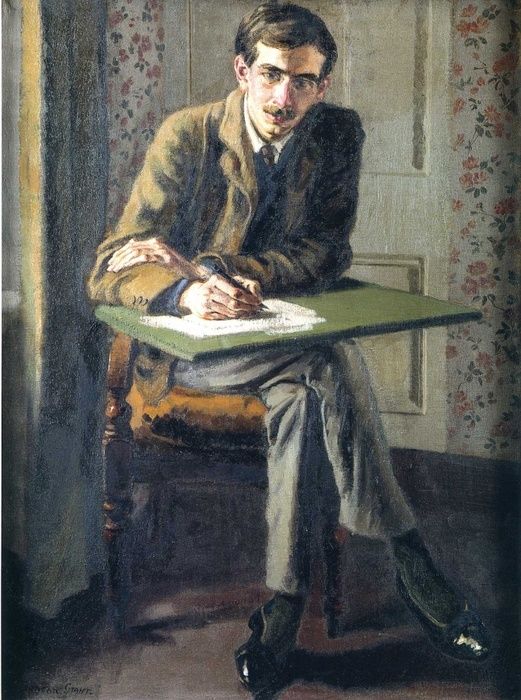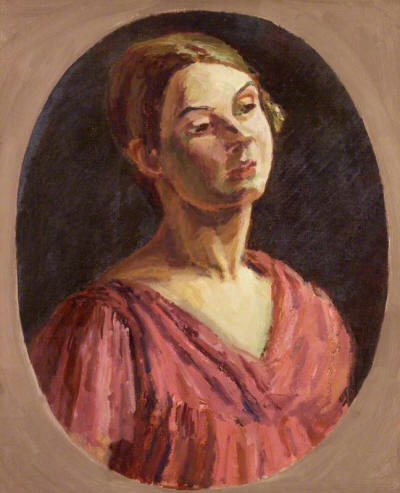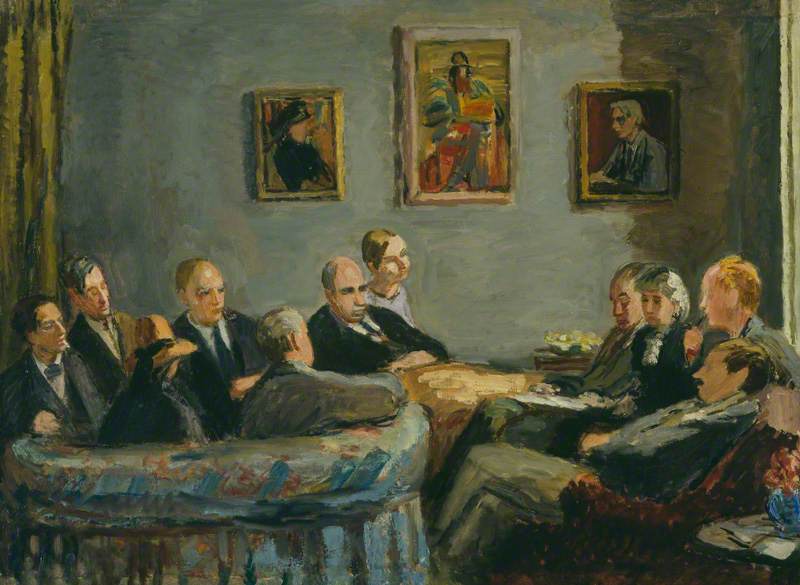

Partner Duncan Grant
Queer Places:
Eton College, Windsor SL4 6DW, Regno Unito
University of Cambridge, 4 Mill Ln, Cambridge CB2 1RZ
26 Fitzroy Square, Fitzrovia, London W1T 6BT, Regno Unito
46 Gordon Square, Kings Cross, London WC1H 0PD, Regno Unito
Tilton, West Firle, Lewes BN8 6LL, Regno Unito
 John
Maynard Keynes, 1st Baron Keynes[2]
CB FBA (5 June 1883 – 21 April 1946), was a British economist whose ideas
fundamentally changed the theory and practice of macroeconomics and the
economic policies of governments. He was part of the
Cambridge Apostles. He built on and greatly refined earlier work
on the causes of business cycles, and was one of the most influential
economists of the 20th century and the founder of modern macroeconomics
theory.[3][4][5][6]
His ideas are the basis for the school of thought known as Keynesian
economics, and its various offshoots. Glyn
Philpot’s Portrait of a Man in Black (1913) depicts
Robert Allerton, his then lover, as does
Duncan Grant’s painting of
John Maynard Keynes (1908). These
works show remarkable intimacy, and informed interpretations of the works are
not possible if a viewer is ignorant of the sexual relations between the men.
This is not a concession to prurient interests, but important art historical
data similar to that commonly provided when the artist is known to have been
heterosexual. The character Hugh Fawcett ("the best brain in the Foreign
Office" but not much use as a matchmaker) in The River Flows (1926) by
F.L. Lucas, was based on
John Maynard Keynes
John
Maynard Keynes, 1st Baron Keynes[2]
CB FBA (5 June 1883 – 21 April 1946), was a British economist whose ideas
fundamentally changed the theory and practice of macroeconomics and the
economic policies of governments. He was part of the
Cambridge Apostles. He built on and greatly refined earlier work
on the causes of business cycles, and was one of the most influential
economists of the 20th century and the founder of modern macroeconomics
theory.[3][4][5][6]
His ideas are the basis for the school of thought known as Keynesian
economics, and its various offshoots. Glyn
Philpot’s Portrait of a Man in Black (1913) depicts
Robert Allerton, his then lover, as does
Duncan Grant’s painting of
John Maynard Keynes (1908). These
works show remarkable intimacy, and informed interpretations of the works are
not possible if a viewer is ignorant of the sexual relations between the men.
This is not a concession to prurient interests, but important art historical
data similar to that commonly provided when the artist is known to have been
heterosexual. The character Hugh Fawcett ("the best brain in the Foreign
Office" but not much use as a matchmaker) in The River Flows (1926) by
F.L. Lucas, was based on
John Maynard Keynes
Lytton Strachey was part of the Cambridge Apostles like John Maynard Keynes. The relation between the two leaders within the Apostles was always an ambivalent one, riven by rivalry over their loves. There was the charming George Duckworth: Strachey discovered by accident that Keynes was also after him. There was abitter tussle as to who should sponsor him for the Apostolic fellowship; Keynes, being more ruthless, won. We learn that "for two months following the election of Duckworth, Lytton was filled with an almost demented hatred of Keynes." He even "launched an extraordinary onslaught upon Keynes before the assembled Apostles." Shockingly unethical, according to the gospel of the Venerable Moore. Shortly Strachey transferred his affections to Bernard Winthrop Swithinbank, and Duckworth transferred his to the irresistible Duncan Grant. So Strachey was one, or possible two, up. Then Lytton became ensnared by the beauty of Duncan. The next test for the Apostle Moore's gospel was when Lytton found out - again by accident, for he hadn't much psychological perception - that the predatory Keynes had captured Duncan from him, and that Duncan returned his love. Accepting the mutuality of this esteem, Lytton decided to apply Old Moore's almanac and strike the note of magnanimity: "I don't hate you and, if you were here now, I should probably kiss you, except that Duncan would be jealous, which would never do!" Keynes wrote back in similar mood: "Your letter made me cry."

John Maynard Keynes by Duncan Grant

Lydia Lopokova
Duncan Grant (1885–1978)
National Portrait Gallery, London

The Memoir Club (Duncan Grant; Leonard Woolf; Vanessa Bell; Clive Bell; David Garnett; Baron Keynes; Lydia Lopokova; Sir Desmond MacCarthy; Mary MacCarthy; Quentin Bell; E. M. Forster)
Vanessa Bell (1879–1961)
National Portrait Gallery, London
Tilton House, Selmeston
During the Great Depression of the 1930s, Keynes spearheaded a revolution in economic thinking, challenging the ideas of neoclassical economics that held that free markets would, in the short to medium term, automatically provide full employment, as long as workers were flexible in their wage demands. He instead argued that aggregate demand determined the overall level of economic activity and that inadequate aggregate demand could lead to prolonged periods of high unemployment. Keynes advocated the use of fiscal and monetary policies to mitigate the adverse effects of economic recessions and depressions. Keynes's magnum opus, The General Theory of Employment, Interest and Money, was published in 1936.
The leading Western economies adopted Keynes's policy recommendations before the outbreak of World War II, and in the two decades following Keynes's death in 1946, almost all capitalist governments had done so. Keynes's influence waned in the 1970s, partly as a result of the stagflation that plagued the Anglo-American economies during that decade, and partly because of criticism of Keynesian policies by Milton Friedman and other monetarists.[7] He and other economists had disputed the ability of government to regulate the business cycle favourably with fiscal policy.[8]
The advent of the global financial crisis of 2007–2008 caused a resurgence in Keynesian thought. Keynesian economics provided the theoretical underpinning for economic policies undertaken in response to the crisis by President Barack Obama of the United States, Prime Minister Gordon Brown of the United Kingdom, and other heads of governments.[9]
When Time magazine included Keynes among its Most Important People of the Century in 1999, it said that "his radical idea that governments should spend money they don't have may have saved capitalism."[10] The Economist has described Keynes as "Britain's most famous 20th-century economist."[11] In addition to being an economist, Keynes was also a civil servant, a director of the Bank of England, and a part of the Bloomsbury Group of intellectuals.[12]
Keynes's early romantic and sexual relationships were exclusively with men.[148] Keynes had been in relationships while at Eton and Cambridge; significant among these early partners were Dilly Knox and Daniel Macmillan.[26][149] Keynes was open about his affairs, and from 1901 to 1915 kept separate diaries in which he tabulated his many sexual encounters.[150][151] Keynes's relationship and later close friendship with Macmillan was to be fortunate, as Macmillan's company first published his tract Economic Consequences of the Peace.[152]
Attitudes in the Bloomsbury Group, in which Keynes was avidly involved, were relaxed about homosexuality. Keynes, together with writer Lytton Strachey, had reshaped the Victorian attitudes of the Cambridge Apostles: "since [their] time, homosexual relations among the members were for a time common", wrote Bertrand Russell.[153] The artist Duncan Grant, whom he met in 1908, was one of Keynes's great loves. Keynes was also involved with Lytton Strachey,[148] though they were for the most part love rivals, not lovers. Keynes had won the affections of Arthur Hobhouse,[154] and as with Grant, fell out with a jealous Strachey for it.[155] Strachey had previously found himself put off by Keynes, not least because of his manner of "treat[ing] his love affairs statistically".[156]
Political opponents have used Keynes's sexuality to attack his academic work.[157] One line of attack held that he was uninterested in the long term ramifications of his theories because he had no children.[157]
Keynes's friends in the Bloomsbury Group were initially surprised when, in his later years, he began dating and pursuing affairs with women,[158] demonstrating himself to be bisexual.[159] Ray Costelloe (who would later marry Oliver Strachey) was an early heterosexual interest of Keynes.[160] In 1906, Keynes had written of this infatuation that, "I seem to have fallen in love with Ray a little bit, but as she isn't male I haven't [been] able to think of any suitable steps to take."[161]
My published books: